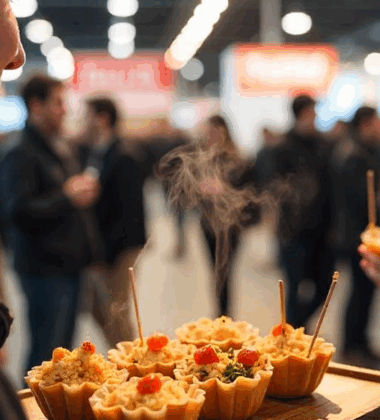At global trade events like the Global Products Expo USA, traditional product booths are rapidly evolving. Sampling tables and static signage are giving way to multisensory activations that blur the lines between culinary experiences and visual spectacles. One concept leading this transformation? Edible art.
Edible art—whether through immersive food installations, sculptural tastings, or interactive culinary exhibits—is more than a visual gimmick. It’s a storytelling tool, a brand differentiator, and increasingly, a crowd magnet. In the age of content creation and consumer experience, edible art delivers something few tactics can: a moment that’s tasted, seen, remembered, and shared.
The Rise of Edible Art at Trade Shows
Visual storytelling has long been part of marketing. But in the food and beverage industry, brands are discovering that combining artistry with edibility creates deeper engagement. Edible installations appeal to multiple senses at once, turning a booth visit into an event. Attendees don’t just learn about your brand—they step into it.
At the 2024 edition of the Global Products Expo, a seaweed snack brand suspended translucent edible panels in ocean hues across their booth ceiling. Visitors walked beneath a canopy of edible sculptures inspired by coastal ecosystems. Every leaf was infused with one of their SKUs. The display doubled as a product showcase and a statement on sustainability. And the result? A record 3.5x increase in dwell time compared to their previous year’s setup.
What Exactly Is Edible Art?
Edible art encompasses any food product or sampling method presented as a visual or interactive art piece. This includes:
- Sculptural tastings (e.g., chocolate busts, edible flower walls)
- Interactive food installations (e.g., build-your-own flavor mosaics)
- Culinary architecture (e.g., booths made of or wrapped in edible materials)
- Performative tastings (e.g., chefs assembling plated art live)
It’s not just about being eye-catching. The goal is to immerse the visitor in your brand’s narrative using design, form, and flavor simultaneously.
Why Edible Art Works
In a competitive trade show environment, attention is scarce. Edible art grabs attention—but more importantly, it holds it.
Here’s why this format is becoming a go-to strategy:
1. It Creates Immediate Visual Prominence
Booths featuring edible installations stand out in a sea of standard branding. Their scale, novelty, and shareability make them natural traffic magnets. Attendees snap photos, tag brands, and remember who offered the most striking experience—not just the best flavor.
According to a 2024 Expo Exhibitor Report:
- Booths with edible art elements saw a 2.1x increase in foot traffic.
- They were also 4.6x more likely to be featured in attendee-generated social content.
2. It Promises Multi-Level Engagement
Edible art invites attendees to interact with your product in new ways. Touch it. Smell it. Watch it being created. Even participate in assembling it. That promise of discovery turns passive samplers into curious explorers.
And curiosity leads to memory.
One health bar startup invited attendees to “paint” their snack by dipping bars into all-natural sauces like beet tahini and matcha ganache. The act of customizing and visually creating made the moment share-worthy—and more personally memorable.
3. It Delivers Proof of Brand Vision
Brands that invest in edible art installations show—not just tell—their creativity, values, and uniqueness.
Consider a regenerative cacao brand that built a rainforest wall from edible moss and cocoa nibs. Each leaf represented one of their reforested plots. It wasn’t just beautiful—it was brand proof. Guests left understanding the company’s environmental mission more deeply than any brochure could convey.
Formats of Edible Installations to Explore
Here are some leading formats that exhibitors are using to make edible art functional, engaging, and aligned with their core messaging:
1. Ingredient Walls
These are vertical displays made entirely from real (or replica) ingredients—arranged by color, origin, or flavor profile. Visitors often get to pull samples directly from the wall, blending education with interaction.
Best for: Organic brands, farm-to-table missions, provenance storytelling.
2. Live Culinary Sculpting
A chef sculpts or plates live, forming a food-based artwork in real time. The performance aspect adds drama, and guests can often eat the finished product.
Best for: High-end culinary brands, innovation labs, or chef-led concepts.
3. Interactive Flavor Canvases
Guests use edible “paints,” textures, or toppings to design their own snack or meal item. It allows personalization—and creativity.
Best for: Functional food brands, wellness startups, sensory-focused products.
4. Taste Mazes or Flavor Trails
Attendees follow a spatial path with taste stations linked to a larger artistic concept. Think edible storybooks, flavor “quests,” or walk-through taste gardens.
Best for: Multi-product portfolios, cultural or heritage brands, flavor R&D.
5. Food-Inspired Visual Installations
Even if the structure isn’t edible, it visually references the food product. For example, a honey brand might build hexagonal tasting chambers that resemble a beehive.
Best for: Thematic storytelling, single-ingredient focus, design-forward brands.
Real-World Expo Success Stories
“Seeds of Change” by a Grain Startup
This installation featured thousands of edible seed pods suspended mid-air using invisible thread. Visitors could pick one pod to taste—and read the story of the grain blend inside. It was part product demo, part sculpture. The brand’s booth won “Best of Show” and landed in 12 industry press recaps.
“The World of Salt” by a Condiment Company
A mirrored table displayed 50 salts from around the globe arranged in minimalist glass cubes. Each cube had a tasting spoon and a linked audio story (via QR code) describing its origin. The result? Visitors spent an average of 8 minutes at the booth—4x the expo average.
“Flavor Portraits” by a Beverage Brand
Guests were photographed, then received a custom mocktail based on their personality type. The drink was plated with edible inks forming a color splash “portrait.” Lines snaked down the expo aisle for this experience, which boosted lead capture by over 300%.
Designing Your Own Edible Art Activation
If you’re considering an edible installation for your next trade show appearance, here’s a simplified roadmap:
1. Start with Your Brand Narrative
What story are you telling? Is it about heritage, sustainability, bold flavor, or cutting-edge science? Let this narrative determine your visual concept.
2. Define the Desired Emotion
Do you want visitors to feel wonder, nostalgia, curiosity, joy? Your emotional target will shape the form of the experience.
3. Collaborate with Creative Talent
Bring in food artists, chefs, or experiential designers early. Their insights will help balance aesthetic impact with food safety and logistics.
4. Design for Interaction
Allow attendees to touch, taste, change, or co-create. Passive displays are missed opportunities.
5. Integrate Digital Elements
Use QR codes, AR overlays, or photo ops that extend the experience beyond the booth. Make your art shareable, taggable, and follow-up friendly.
Who Should Use Edible Art?
- Event planners looking to create wow-factor moments
- F&B marketing teams introducing new SKUs or rebranding
- Emerging brands aiming to stand out on a limited budget
- Sustainability-focused companies who want to demonstrate values creatively
- Sensory researchers and R&D teams engaging attendees in data-driven flavor experiences
Looking Ahead: Edible Art as Brand Strategy
As trade shows continue to evolve into media-rich, content-driven environments, edible art is becoming more than a novelty—it’s a strategic pillar for brand visibility.
What we see in 2025 and beyond will likely go further: edible screens, temperature-responsive visuals, AI-driven flavor design. But at the core will remain a simple truth: people remember what they feel, and edible art makes food emotional.
Final Taste
In a landscape of constant noise, edible art installations allow food and beverage brands to whisper something powerful: This is who we are. This is how we taste. This is how we live in your memory.
As you plan your next expo appearance—especially if you’re exhibiting at the Global Products Expo USA (June 26–28, 2025, at the New Jersey Expo Center)—ask yourself not just what you’re offering to taste, but how you’re asking visitors to feel.
Because when the product becomes the medium—and the moment becomes the message—you’re not just sampling. You’re creating a masterpiece.





